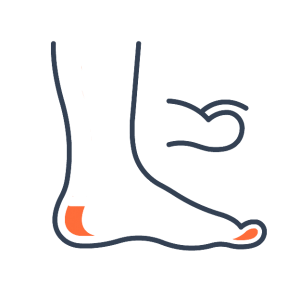Calluses and corns affect more people than any other kind of foot problem, but fortunately, they can be treated.
When we walk or stand, our feet carry the burden of our body weight and bear the various pressures of movement and constraints of our footwear. Sometimes extra friction or pressure falls on a particular area of the foot, and the body produces thickened areas of skin. These hard patches of skin are called calluses. They are part of the body’s defence system to protect the underlying tissue. If the cause of the pressure is not relieved, calluses get thicker and can become painful.
If the pressure becomes concentrated in a small area, a hard corn may develop. Sometimes, the corn or callus’s pressure may produce inflammation, which can result in acute pain, swelling, and redness.

Where are corns & calluses found?
Corns and calluses are most often found on the balls of the feet or the top of toes. They can also be found on heels and even along the sides of your toenails. Sometimes soft corns may form between the toes where the skin is moist from sweat or inadequate drying, and these appear soft, white and rubbery but often more painful.
Warning signals
Calluses and corns can be early warning signals of more complex foot disorders. Because they are caused by continuous pressure in one particular area, they may indicate abnormalities or deformities in your bone structure or the way you walk. However, they might be caused by ill-fitting or inappropriate footwear.
Who is predisposed to corns & calluses?
Some people have a natural tendency to develop calluses because of their skin type. For instance, older adults have less fatty tissue and elasticity in their feet. Because of this lack of padding, calluses may form on the bottom of their feet. Also, those who work in occupations that require them to spend a lot of time on their feet are prone to developing calluses.
